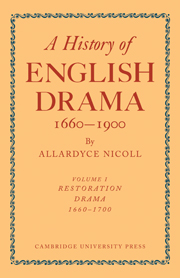Appendix A - HISTORY OF THE PLAYHOUSES: 1660–1700
Published online by Cambridge University Press: 05 November 2011
Summary
In September 1642 playing had been stopped by the new Puritan government, “while these sad Causes and set times of Humuliation doe continue,” and later ordinances in 1647 and 1648 were issued for the purpose of maintaining the prohibition. The impoverished actors petitioned in vain, and officially those whose hearts had not been made sour by the prevailing austerity had to content themselves with imaginary performances as they read their dramas in printed text. Of such play-lovers there must indeed have been many if we are to judge by the truly extraordinary wealth of tragedies and comedies that came flooding from the printing houses during these eighteen years. Even if the parliamentary regulations had been strictly enforced, we may be sure that when the theatres reopened in 1660 their fare would have been well known to at least a large part of the eager audiences who flocked to their doors.
But the regulations were not strictly enforced, and recent studies of the drama during the Commonwealth have easily demonstrated that surreptitious performances were given at various theatres whenever the old actors were able to gather a company and an audience—and this was frequently. No doubt the players risked imprisonment and the spectators a fine, yet the severity of the punishment could not prevent either from indulging in these now forbidden joys.
- Type
- Chapter
- Information
- History of English Drama, 1660–1900 , pp. 284 - 342Publisher: Cambridge University PressPrint publication year: 1952



